Please ask permission to use articles to:
copyright@exakta.org
 Exa Six versions of the first model Maurizio Frizziero This text was written in Italian in 1992. (before Internet connection) Apologies by the Author the mistakes in the translation.
Version 1, 1952 (A&R) Exa 311, Engraved nameplate, 1950 (ECC) Now I own some other cameras, like some with ribbed pattern and one with a black bayonet flange, bought in USA by Bruce Pick (BpickPhoto@aol.com), a serious dealer-collector whose updated list can be found at this page 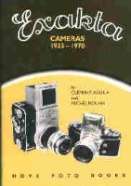 As you can see, the confusion begins: A&R dates 1952 what the ECC attributes at 1950. Considering the fact that similar situations will often be repeated and that not always my bodies will coincide aesthetically with those printed on A&R's book, from the beginning we will proceed in homemanner, annotating live the situation according to the differences that we will go to compare among the two classifications and/or among the classifications and the items of my collection. As you can see, the confusion begins: A&R dates 1952 what the ECC attributes at 1950. Considering the fact that similar situations will often be repeated and that not always my bodies will coincide aesthetically with those printed on A&R's book, from the beginning we will proceed in homemanner, annotating live the situation according to the differences that we will go to compare among the two classifications and/or among the classifications and the items of my collection. On the A&R's book you can find a lot of details on the Exas.  The bipolar flash sockets on the left and no cover shutter release button on the right  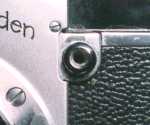 My higher Exa body number is 224.679, inside the range identified by A&R (200.000-235.000). This version has two bipolar flash sockets, M and X, for two
different syncronizations, the first one at all speeds, the second one for electronic flash.
Please look at the front plate: on the left you can see the flash sockets, on the centre the front plate, on the right the shutter release button. In these three elements are all the identification factors of this camera: it is the only one to have the two bipolar flash sockets, so you can read the M and the X on the bottom of the front plate. My higher Exa body number is 224.679, inside the range identified by A&R (200.000-235.000). This version has two bipolar flash sockets, M and X, for two
different syncronizations, the first one at all speeds, the second one for electronic flash.
Please look at the front plate: on the left you can see the flash sockets, on the centre the front plate, on the right the shutter release button. In these three elements are all the identification factors of this camera: it is the only one to have the two bipolar flash sockets, so you can read the M and the X on the bottom of the front plate. The ribbed pattern (left). - The waist level finder with the locking arm (right). 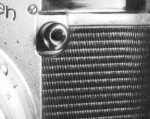
This model, in confront of the following ones, has no protective cover over the shutter release button to avoid accidental clicks. This problem was solved by a small brainy arm on the left hand of the wlf, whose purpose was that of locking the button when the wlf was closed.  The protective cover, hinged on the screw nearer to the button, allows to date easily as the Exas as the Exaktas: the protection was used on the Exakta VX, version 2, during 1955, and it has been adopted immediately on the Second version of the Exa. In the same time the waist level finder was simplified: the little arm (block of the release button) was removed.
The protective cover, hinged on the screw nearer to the button, allows to date easily as the Exas as the Exaktas: the protection was used on the Exakta VX, version 2, during 1955, and it has been adopted immediately on the Second version of the Exa. In the same time the waist level finder was simplified: the little arm (block of the release button) was removed.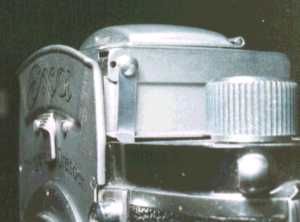 Among the characteristics of this model and of every its version there is a lever, yes a lever!, that allows to go across progressional speed ranges, from B to 1/25, 1/50, 1/100, 1/150. There is also a inconceivable sector shutter, that has been never reused if not in a demential Ic, an anachronistic attempt of archeological retrieval happened on 1986.
Among the characteristics of this model and of every its version there is a lever, yes a lever!, that allows to go across progressional speed ranges, from B to 1/25, 1/50, 1/100, 1/150. There is also a inconceivable sector shutter, that has been never reused if not in a demential Ic, an anachronistic attempt of archeological retrieval happened on 1986. 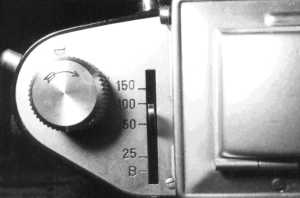 On the A&R's book you can find a lot of details on the Exas.
On the A&R's book you can find a lot of details on the Exas.Let us see how it works. Let us take the camera in our hands. Let us load the film, revolving the right grained knob in hourly sense. The mirror goes to 45 degrees, pushing under itself the sector shutter. When the release button is pressed the mirror returns immediately in the upper position while the sector, now free from the impact of the mirror, goes up again with the delayed programmed time. This system, with optics longer than 100 mm or in macrophoto with extension tubes or bellows, can vignet the film. Norlin Rober adds among the causes of vignetting the use of fast lenses like the Angenieux 50/1,5. Not satisfied of this information Norlin tell us also that the M and X were adopted only from 1953, while in two preceding years these letters were respectively V and E. Then he gives us another information about the way of loading the film, with the emulsion toward the exterior, on the contrary respect to the Exakta. The last Rober's difference (I have seen it buying this kind of Exa by Bruce Pick, during 1995) concerns the lens bayonet on the first Exas: according to him it was black. Before or then I'll find out if everything that has been written about the Exakta is true.  If you look at the body, often you can find, on the top or on the bottom, rarely on the sides, slightly different inscrip-
If you look at the body, often you can find, on the top or on the bottom, rarely on the sides, slightly different inscrip-tions: "U.S.S.R. Occupied Germany". In such a case it is possible the camera was sold in USA. Exa Version 1, 1952 (A&R, Variant) Exa 311, Engraved nameplate, 1950 (ECC) 232.948, a body number near, according to A&R, to the upper range limit of the Version 1. This Exa differs from the preceding only for the protective cover of the shutter release button, surely not added in following times. By intuition it should be coeval of the first Varex VX and it 'd come few days before the A&R's Version 2. The waist level finder has lost its block lever because this function is made by the protective cover. On this camera there is a variation that will be after used up to the last version: the back could be removed by taking off the spindle of the hinge. Norlin Rober doesn't notice it while A&R attibutes this variation to the Version 4.
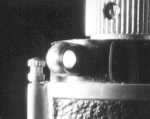 Here you can see the head of the spindle
Here you can see the head of the spindle
Exa Version 2, 1955 (A&R) Exa 311, Engraved nameplate, 1950 (ECC) The modifications respect to the Version 1 are: the protective cover and two black coaxial sockets, M and X, the same letters used on the previous camera.
Exa
Exa
Exa
|
Traduzione
Se desiderate leggere queste pagine in italiano potete
cliccare qui
 The spindle of the hing is not present on the first version.
The spindle of the hing is not present on the first version. On the front part of the wlf there are again the white inscriptions Rheinmetall (italic, on the first line), Sommerda and Germany.
On the front part of the wlf there are again the white inscriptions Rheinmetall (italic, on the first line), Sommerda and Germany.
 The unique modification characterizing this Version is the embossed logo, even if the graphics is the traditional one. The body number of my camera is 548.566, inside, this time, to the A&R's range (520.000-560.000).
The unique modification characterizing this Version is the embossed logo, even if the graphics is the traditional one. The body number of my camera is 548.566, inside, this time, to the A&R's range (520.000-560.000). Useless to continue to speak about the logo even if we have not said that two years before the same inscription, tilted toward the right, appeared, even if engraved, on the Exa II's frontplate.
The waist level finder has been simplified and has been covered by the
usual black leatherette. The body numbers of my cameras go from 580.055 to 619.153 inside the A&R's range. These cameras show a peculiarity that can be seen with difficulty on older cameras: the body's and the back's bottom have similar chrome. The time has instead worked on the preceding versions: if you support a preceding version on a plain, the back is lifted about 1 mm and the body's chrome suffers an usury that day after day becomes more evident. From this usury have been saved only the last cameras, very probably forgotten somewhere after the Japanese surpass.
Useless to continue to speak about the logo even if we have not said that two years before the same inscription, tilted toward the right, appeared, even if engraved, on the Exa II's frontplate.
The waist level finder has been simplified and has been covered by the
usual black leatherette. The body numbers of my cameras go from 580.055 to 619.153 inside the A&R's range. These cameras show a peculiarity that can be seen with difficulty on older cameras: the body's and the back's bottom have similar chrome. The time has instead worked on the preceding versions: if you support a preceding version on a plain, the back is lifted about 1 mm and the body's chrome suffers an usury that day after day becomes more evident. From this usury have been saved only the last cameras, very probably forgotten somewhere after the Japanese surpass. If we speak about the frontplate the upper round form has been changed and the engraved "Ihagee Dresden" inscription is in thin capital letters.
If we speak about the frontplate the upper round form has been changed and the engraved "Ihagee Dresden" inscription is in thin capital letters.